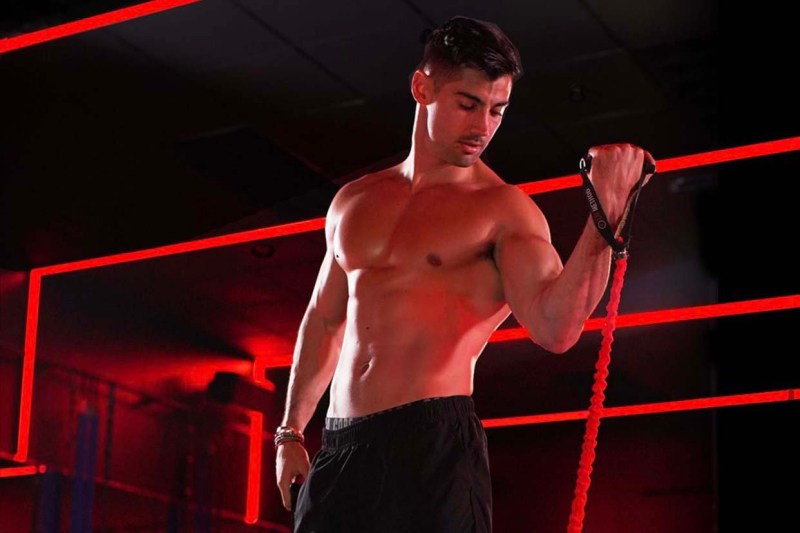
Justin Norris was just another high school athlete when a freak home accident derailed all of his sports goals. In conversation with The Manual, he holds up a forearm bearing a chevron-shaped scar that nearly encircles it. He mentions falling glass. “I faced a long road to recovery,” the 31-year-old says from his home in Los Angeles. After the multiple surgeries and subsequent physical therapy, he finally got back in the weight room, only to find that his muscles couldn’t handle the free weights they once could. And so he started using resistance bands as an alternative. Something about the lack of impact on his body despite their pressure not only allowed him to train but to make substantial gains, and by the end of his own makeshift summer conditioning program, he’d gained 20 pounds of lean mass.
Now the founder of LIT Method, a low-impact training methodology which counts Jay-Z and MLB all-star Adrian Gonzalez as investors, Norris evangelizes to clients with the good news of his unique approach to strength development. “The number-one thing that people notice, regardless of training style, is that strength training doesn’t mean weight training,” he says. Sure, a burpee can get you results, but it can blow out a shoulder. “A burpee is no different than an inchworm, which requires no impact,” he says. “We just do it without putting force on injury-[prone] joints.” Furthermore, these movements allow a guy to better focus on the muscle itself, isolating for more effective results while expanding range of motion.
“We wanted to give people an alternative to use that CrossFit intensity but in a low impact setting,” Norris says. He’s got no axe to grind with the training philosophy of it, and indeed claims the greatest respect for its Games and athletes. But with a combination of resistance bands and other low-impact exercises, he’s building a better body one client at a time, and the numbers are really starting to add up. “You don’t have to beat your body down to get results,” he continues. “It’s not going to happen off the first workout. [But] give it 30 days and see what happens.”
In accordance to his philosophy, Norris adapted some of his and his clients’ favorite upper body workouts for The Manual. While effective, these series are some of the most distinct we’ve ever seen. While we might normally be skeptical, his long list of clients in one of the most competitive fitness markets in the world indicates he must be on to something.
Squat to Press

The LIT philosophy centers around pre-exhausting muscles through compound movements before burning them to a cinder. As with any exercise, leave yourself somewhere to go, but know that you’ll be on fire by workout’s end.
Targeted Muscles: Lower body, chest, arms, shoulders
Equipment Needed: A 30-pound resistance band (dumbbells may be substituted)
Sets: One
Rest: One minute between
Execution:
- 20 reps, Squat to overhead press
- Rest
- 15 reps, Squat to overhead press
- Rest
- AMRAP (As Many Reps as Possible), to failure
Bent-Over Rows

A classic back-blaster, this will get your lats as wide as elephant ears while building functional strength in your biceps and forearms.
Targeted Muscles: Upper back, core, forearms, biceps
Equipment Needed: A 30- to 50-pound resistance band (dumbbells may be substituted)
Sets: One
Rest: One minute between
Execution:
- 15 reps, Bent-over row
- Rest
- 12 reps, Bent-over row
- Rest
- AMRAP, to failure
Read more: Best Back Workouts
Laying Chest Press

Like the bench press but requiring none of the equipment, find a flat spot and loop your band around your back before lying back on on it. Press the world away.
Targeted Muscles: Chest, triceps, core
Equipment Needed: A 30- to 50-pound resistance band (dumbbells may be substituted)
Sets: One
Rest: One minute between
Execution:
- 15 reps, Laying chest press
- Rest
- 12 reps, Laying chest press
- Rest
- AMRAP, to failure
Read more: Best Chest Workouts
Shoulder Presses

You don’t get boulder shoulders from driving to work. Time to lift like Atlas. Loop the band under your feet and palms while standing. Keep your core tight, lifting and lowering under control.
Targeted Muscles: Shoulders, core, triceps, some chest
Equipment Needed: A 30- to 50-pound resistance band (dumbbells may be substituted)
Sets: One
Rest: One minute between
Execution:
- 15 reps, Shoulder presses
- Rest
- 12 reps, Shoulder presses
- Rest
- AMRAP, to failure
Read more: Best Shoulder Workouts
Bicep Curls

Build fearsome peaks with this classic gym exercise. With the band looped under your feet, curl up with both arms, either rotating the palms toward your face or with the palms facing in.
Targeted Muscles: Biceps, forearms
Equipment Needed: A 30- to 50-pound resistance band (dumbbells may be substituted)
Sets: One
Rest: One minute between
Execution:
- 15 reps, Bicep curls
- Rest
- 12 reps, Bicep curls
- Rest
- 12 reps, Eccentric bicep curls (lower for three seconds)
Read more: Best Resistance Band Workouts
Tricep Kickbacks

Horseshoes aren’t found solely in stables. Build the backs of your arms with this staple, looping the band around a pole and then over your body, grasping it in both palms. Kick back to extension of your arms, returning to a 90-degree angle for the start.
Targeted Muscles: Triceps, forearms
Equipment Needed: A 30- to 50-pound resistance band (dumbbells may be substituted)
Sets: One
Rest: One minute between
Execution:
- 15 reps, Shoulder presses
- Rest
- 12 reps, Shoulder presses
- Rest
- AMRAP, to failure



